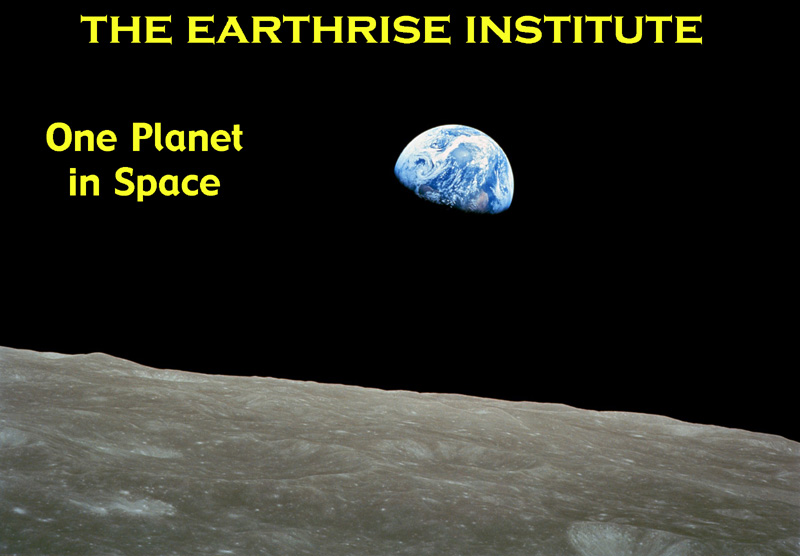
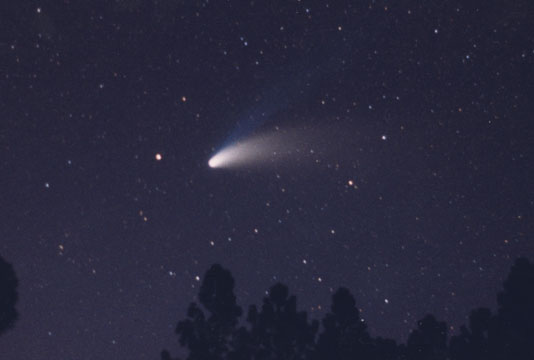
TALLY ENTRIES 731-740
As I write these words, the calendar year of 2022 is drawing to its close. For me personally, 2022 was a relatively quiet and uneventful year -- perhaps not a bad thing at my present age -- with the biggest happenings being my older son Zachary's moving back to Australia in August (although he and his girlfriend Karina paid a visit back here earlier this month) and an unpleasant physical ailment I had to deal with, also in August. On the wider national and international scene many things remain quite unsettled, although there were some occasional hopeful signs here and there. From the perspective of astronomy and space 2022 could be considered a positive and productive year, which included the successful DART mission (which I discuss in my tally entry for (65803) Didymos (no. 725)), the recently-completed unmanned Artemis 1 mission (which, despite my lifelong interest in and advocacy for human spaceflight, I am actually somewhat ambivalent about, since I have come to feel that there are a host of serious issues here on Earth that we as humans need to confront and deal with before we can seriously consider expanding into space, and in any event I believe any decisions to such effect should be left to the generations that follow mine), and the successful deployment of the James Webb Space Telescope, which among many, many other wondrous accomplishments managed to image Comet Hale-Bopp (no. 199) -- at the enormous heliocentric distance of 46.2 AU -- in early July.
Before the year ends, I have managed to add one additional comet to my tally, giving me my 19th tally addition and, overall, my 26th comet, for the year, something that strikes me as at least somewhat remarkable since I now consider myself "semi-retired" from visual astronomical activities. The comet in question was discovered by the Pan-STARRS survey in Hawaii as far back as October 22, 2019, at which time it was located at a heliocentric distance of 10.4 AU and almost 3 1/2 years away from perihelion passage. At the time of its discovery it appeared as a stellar object near 21st magnitude and didn't exhibit any cometary activity, and was accordingly announced under the designation A/2019 U5. About a year later large telescopes began to detect weak activity, and in April 2021 it was formally re-designated as a comet.
Comet PANSTARRS is traveling in a steeply-inclined retrograde orbit with an inclination of 113.5 degrees. It was at opposition in early May 2022, and according to various reports I've read and images I've seen it was apparently close to 14th magnitude around that time, i.e., bright enough for visual observations, and had I been operating at my previous level of activity I almost certainly would have looked for it and, more than likely, would have successfully detected it. As it was, I waited until after it went through conjunction with the sun (23 degrees north of it) in mid-October and subsequently re-emerged into the morning sky; again, various reports and images (including a set of images I obtained via the Las Cumbres Observatory network on December 20) indicated it was bright enough to detect visually. On the morning of December 22 I successfully did so; it appeared as a small, moderately condensed object slightly brighter than 14th magnitude.
At present the comet is located in central Virgo some four degrees northwest of the star Tau Virginis and, having just passed through a stationary point, is traveling almost due southward at a relatively slow 6 arcminutes per day. Over the coming weeks it accelerates and curves toward a more directly westward motion, and will pass through opposition (and be at its closest to Earth, 2.63 AU) during the latter part of March, when it will be located three degrees west-southwest of the star Eta Virginis and traveling at half a degree per day. (At that time it will also be close to perihelion passage, making the viewing geometry about as favorable as it can be.) The comet crosses into southeastern Leo in early April and into Sextans a month later, but not too long thereafter it starts curving more directly southward as it goes through its other stationary point at the beginning of July. By that time it is becoming inaccessible from my latitude, although observers in the southern hemisphere will still be able to follow it; meanwhile, it enters Hydra in early August and is in conjunction with the sun (25 degrees south of it) shortly before the end of that month. It begins emerging into the southern hemisphere's morning sky by November and is at opposition again in early February 2024, when it will be located at a declination of -46 degrees about three degrees southwest of the star Lambda Velorum.
Since it is faint and distant and otherwise relatively nondescript, I will probably only be observing Comet PANSTARRS on an occasional basis over the next few months. It may brighten by perhaps a half-magnitude or so by the time of perihelion passage, and I may follow it for perhaps a month or so thereafter, but once it starts fading and getting low in my southwestern sky I will probably be done with it. Observers in the southern hemisphere may still be able to detect it visually as it approaches its opposition in early 2024, but it will likely soon fade from view for them as well.
INITIAL OBSERVATION: 2022 December 22.46 UT, m1 = 13.7, 0.6' coma, DC = 4-5 (41 cm reflector, 229x)
732. COMET 118P/SHOEMAKER-LEVY 4 Perihelion: 2022 November 24.33, q = 1.829 AU
My first tally addition of 2023 is a long-time acquaintance. After its discovery by the team of Carolyn and Eugene "Gene" Shoemaker and David Levy in 1991, I observed it during its subsequent return in 1996-97 (no. 222), during which it reached a peak brightness near 12th magnitude and for a time shared the sky with Comet Hale-Bopp C/1995 O1 (no. 199). Following an unfavorable return in 2003 I observed it again during its return in 2009-10 (no. 464) as a part of "Countdown," and I give a more detailed discussion of its history in its "Countdown" entry. The comet was somewhat fainter than I expected during that return, reaching a peak brightness near 13th magnitude.
As I indicated in its "Countdown" entry, Comet 118P returned under unfavorable geometry in 2016 (although it was duly recovered and, according to the astrometric measurements that were reported, reached a peak brightness perhaps near 16th magnitude), and then in 2020 made a moderately close approach to Jupiter which shortened its orbital period and its perihelion distance. On the present return it was recovered on May 25, 2021 by a team of French astronomers utilizing a remotely-controlled telescope in Chile, although there apparently were no further observations until August of that year, and meanwhile following its conjunction with the sun in late March 2022 it has been followed somewhat extensively since emerging into the morning sky three months later. Although -- again, as I indicated in its "Countdown" entry -- the reduced perihelion distance and the favorable viewing geometry this time around suggested it might become at least somewhat bright, the comet instead seems to have continued the overall fading trend it has exhibited during previous returns, as the reports and images I saw, including some occasional images I took via the Las Cumbres Observatory (LCO) network, indicated it was remaining too faint to be worth attempting visually. However, some of the most recent reports I've seen have suggested it might have brightened some during the recent past, and some additional LCO images I took in mid-January 2023 seemed to support this, so after having to wait out a series of "mini"-snowstorms that were moving through the area I made my first visual attempt on the evening of January 18, and successfully detected it as a diffuse, slightly condensed object of 13th magnitude.
Although Comet 118P passed through perihelion almost two months ago, it is right now at its closest approach to Earth (0.92 AU) and will be at opposition just before the end of January, and accordingly is probably as bright as it is going to get. It is currently located in southern Cancer some 3 1/2 degrees west of the open star cluster M67 and is traveling towards the north-northwest at approximately 15 arcminutes per day; after passing through its stationary point (about 7 degrees north-northwest of its present location, and 4 1/2 degrees southwest of the Praesepe, or "Beehive," star cluster M44) shortly before the end of February it begins traveling just northward of due east and passes a little over one degree north of the center of M44 at the end of March. Since the comet is now pulling away from both the sun and Earth it will likely start fading pretty quickly, and at most I will probably only see it another one or two times.
While I wasn't at all sure I would even be looking for, let alone seeing, Comet 118P this time around, as I wind down my visual observational activities I am actually quite glad that I was in fact able to observe it and add it once again to my tally. Via their many discoveries both the Shoemakers and David Levy made frequent appearances on my tally during much of my earlier years, but during more recent years their only appearances have been due to returns of some of the periodic comets they found; indeed, this is the first time that either of their names appear since this comet's previous return. The Shoemakers terminated their survey program at Palomar in the mid-1990s, and Gene tragically died in a car accident in Australia in 1997, while Carolyn passed away just a year and a half ago. David Levy, meanwhile, remains active in astronomical educational and promotional activities, although in the teeth of all the current survey programs he has not made any comet discoveries since his most recent one in 2006 (Comet 255P/Levy P/2006 T1, no. 397); I last saw him at the 50th Anniversary (and penultimate) Riverside Telescope Makers Conference in 2018. This return of Comet 118P gives the Shoemakers their 21st entry on my lifetime tally and David Levy his 18th, which currently puts them in 4th and 6th place, respectively, for most appearances. I don't expect any more appearances for either of them.
INITIAL OBSERVATION: 2023 January 19.16 UT, m1 = 13.2, 1.4' coma, DC = 2-3 (41 cm reflector, 70x)
733. COMET 96P/MACHHOLZ 1 Perihelion: 2023 January 31.09, q = 0.116 AU
In the entry for Comet 141P/Machholz 2 on its 2020 return (no. 690) I discuss the accomplishments of its discoverer, amateur astronomer Don Machholz, who during a "career" that started in 1975 visually discovered 12 comets, the last three of these coming in the teeth of the comprehensive sky survey programs that have come on-line within the past two decades. He found two of the three comets visually discovered during the decade of the 2010s, with the last of these -- Comet Machholz-Fujikawa-Iwamoto C/2018 V1 (no. 655) -- being the most recent visually-discovered comet as of this writing; I consider it distinctly possible, if not probable, that this may well be the last visually-discovered comet, ever.
I first met Don in early 1981 when I was in the U.S. Navy, and the ship I was stationed on made a liberty port call in San Francisco; I rented a car, drove to San Jose where he was living at the time, called him up, and ended up having dinner with him and his then-wife Laura. We have remained good friends ever since, and I have had the distinct pleasure of confirming or co-confirming four of his subsequent comet discoveries. I last saw him at the penultimate Riverside Telescope Makers Conference in May 2018, where he informed me that he was still hunting for comets on a fairly regular basis; he found his last comet just a little over five months later, and not too long thereafter relocated from California to rural northwestern Arizona. He continued to hunt for comets from there, but, very sadly, he will never find another one, for just a little over six months ago, on August 9, 2022, Don passed away from COVID-19 at the age of 69.
Due to the two short-period comets Don discovered it is theoretically possible that his name can continue to show up on my tally from time to time. He discovered the first of these -- his third overall discovery -- in May 1986, and together with Charles Morris I officially co-confirmed Don's discovery the following morning. Prior to this year I have observed it on four subsequent returns, including in 2007 (no. 405) as a part of "Countdown" and again in 2012 (no. 507). The comet has turned out to be of enormous interest from a scientific perspective, and I discuss some of the reasons for that in its "Countdown" entry.
The comet was badly placed for observation -- especially for the northern hemisphere -- during its 2017 return, and I did not attempt it. Since Comet 96P has been observed near aphelion in the past it can be considered an "annual" comet and thus is not "recovered" in the traditional sense; the first observation of the current return was obtained on May 6, 2022 by Japanese amateur astronomer Hidetaka Sato utilizing a remotely-controlled telescope at Siding Spring Observatory in New South Wales. It continued to be imaged on an occasional basis up through the beginning of December, but -- at least on the images I've seen -- it remained a faint and essentially inactive object.
As the comet was passing through perihelion at the end of January 2023 it spent roughly four days traversing the field-of-view of the LASCO 3 coronagraph aboard the SOHO spacecraft, wherein it put on a spectacular show. As it was doing so researchers Karl Battams and Qicheng Zhang carried out a research program utilizing a special narrow-band filter, and during the course of this they detected several small fragment accompanying the comet -- some of which may be the same as those that have been detected in LASCO images taken during previous returns -- as well as what appears to be a thin trail of smaller debris. These objects are all quite probably related to some of the other items of scientific interest associated with Comet 96P, and at this writing a detailed analysis of the LASCO data is being carried out.

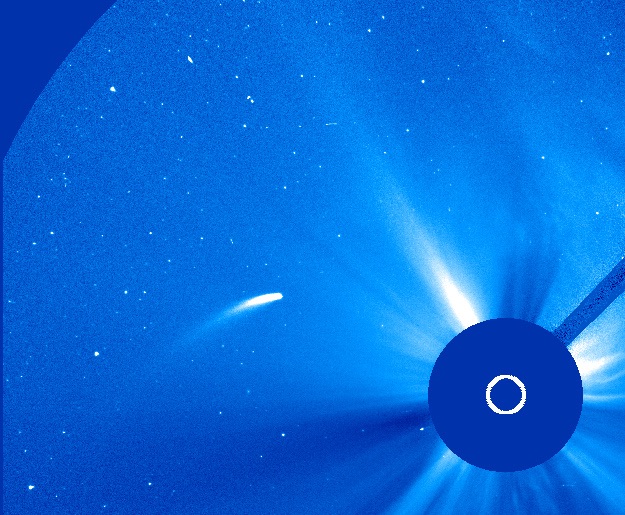 LEFT: Comet discoverers at the 50th Anniversary Riverside Telescope Makers Conference, May 26, 2018. Left to right: David Levy, Jean Mueller, Don Machholz, and me. This would be the last time I saw Don while he was still alive. Photograph by Vickie Moseley. RIGHT: Comet 96P in the LASCO C3 coronagraph aboard SOHO roughly 10 minutes before its perihelion passage on January 31, 2023. Courtesy NASA/ESA.
LEFT: Comet discoverers at the 50th Anniversary Riverside Telescope Makers Conference, May 26, 2018. Left to right: David Levy, Jean Mueller, Don Machholz, and me. This would be the last time I saw Don while he was still alive. Photograph by Vickie Moseley. RIGHT: Comet 96P in the LASCO C3 coronagraph aboard SOHO roughly 10 minutes before its perihelion passage on January 31, 2023. Courtesy NASA/ESA.
Comet 96P was unfavorably placed for viewing after perihelion, and although I had successfully obtained a couple of observations at the similarly unfavorable return in 2002 (no. 300) in my present reduced rate of activity I wasn't sure if I would even attempt it this time around. However, in tribute to Don's recent passing I decided I would make a special attempt to see it at least once. The comet actually did become accessible from the ground a little over a week after perihelion, albeit at a very small elongation, and a few of the images taken then that I've seen show it as a relatively nice object near 8th magnitude with a distinct tail. Per its normal behavior it faded pretty rapidly, and since it is receding on the far side of the sun from Earth its elongation increased only gradually and remained fairly small. I had to contend with moonlight and a continuing series of storms and cloudy weather that passed through New Mexico during February, plus the fact that from my normal observing site I have trees in that particular direction, and I knew things would be pretty much touch-and-go as far as seeing the comet was concerned. Finally, on the morning of February 24 I had relatively decent sky conditions, and although dawn was well underway by the time the comet cleared the trees, I successfully detected it -- and was able to see it for all of two to three minutes before the dawn began to overwhelm it. It appeared as a dim, small, and slightly condensed object roughly between magnitude 11 1/2 to 12, although it's fair to say that in the bright sky I was probably only seeing the inner coma.
While my brief observation under far-from-ideal conditions is not what I would consider an especially satisfying observation, I am nevertheless thrilled to have been able to see one of Don's comets again. (Incidentally, this gives him his 21st entry on my lifetime tally, which puts him tied for 4th place with the Shoemakers (discussed in the previous entry). This is also the 7th-smallest perihelion distance of all the comets on my tally; curiously, Don's second discovery, Comet Machholz 1985e (no. 83), which had a perihelion distance of only 0.106 AU, is in 5th place on that same list.). This will quite probably be my only observation of this comet this time around; while the elongation -- 34 degrees at the time of my observation -- does continue to increase gradually over the coming weeks, it still remains relatively small for quite a while yet, and meanwhile the comet should continue to fade rapidly.
It so happens that Comet 96P's next return, in 2028 (perihelion mid-May), is an especially favorable one, with an approach to Earth of 0.32 AU and a traverse through northern circumpolar skies -- maximum declination +87.5 degrees -- the following month. I have stated in numerous previous entries, however, that I have been looking seriously at "retiring" from visual observing in 2024, ostensibly after the apparitions of Comets 12P/Pons-Brooks and 13P/Olbers are over -- although I may extend that, since a just-discovered apparent (and not yet officially announced) comet found by the ATLAS program -- for which I have already submitted several astrometric measurements from images I've obtained via the Las Cumbres Observatory network -- has the potential to become a spectacular object later that year. (Although, to borrow a cliche, "a lot of stars would have to align" properly for it to do so, if this object does indeed become bright it is accordingly conceivable that I could "go out with a 'bang!'" In any event, I will presumably have more to say about this as the time approaches.) I have always retained the caveat, meanwhile, that I reserve the right to "come out of retirement" if something bright or otherwise interesting comes along. While a lot will depend upon what my personal life circumstances are five years from now -- which I am not going to speculate about at this time -- this appearance by Don's comet might well warrant such a special occasion. Perhaps it would be a fitting tribute to this champion comet discoverer and my long-time friend.
INITIAL OBSERVATION: 2023 February 24.52 UT, m1 = 11.5:, 0.7' coma, DC = 2-3 (41 cm reflector, 229x; low altitude, twilight)
UPDATE (February 28, 2023): I stated above that I probably would not be seeing this comet again, however it turns out that on the last morning of February I had good sky conditions, and although I was concentrating on some of the other morning-sky comets I decided to make another attempt for this one, since its elongation had increased to 37 degrees and it was accordingly rising somewhat earlier. I successfully detected it, and although it had faded some since my initial observation, the fact that I was able to view it in a darker sky (albeit still in twilight) and could follow it for a somewhat longer period of time made this a distinctly more satisfying observation.
At this time I plan no further observations of Comet 96P -- until, conceivably, 2028.
MOST RECENT OBSERVATION: 2023 February 28.52 UT, m1 = 12.2:, 1.6' coma, DC = 2 (41 cm reflector, 229x; twilight)
734. COMET 364P/PANSTARRS Perihelion: 2023 May 14.02, q = 0.801 AU
With this addition to my comet tally this particular comet, with a current orbital period of 4.89 years, becomes the comet with the 5th-shortest orbital period that I have seen on two or more returns. It was originally discovered by the Pan-STARRS survey in Hawaii in February 2013 and I searched unsuccessfully for it during that return, and then I successfully observed it during its subsequent return in 2018 (no. 643); I give a more complete account of its history in that entry. It was during the course of that return -- shortly after its closest approach to Earth, and during the period of time when it was inaccessible from my latitude -- that I underwent the period of hospitalization associated with some of the health issues that are causing me to give serious consideration to the thought of "retiring" from visual comet observing in about a year and a half's time.
At the time of my observation the comet was located 0.18 AU from Earth, and on April 7 it passes 0.121 AU from our planet -- the 16th closest approach to Earth of all the comets on my tally. It is a morning-sky object, presently located in western Hercules and traveling east-ward at three degrees per day. Over the next few weeks it turns gradually towards the east-southeast and accelerates, crossing southern
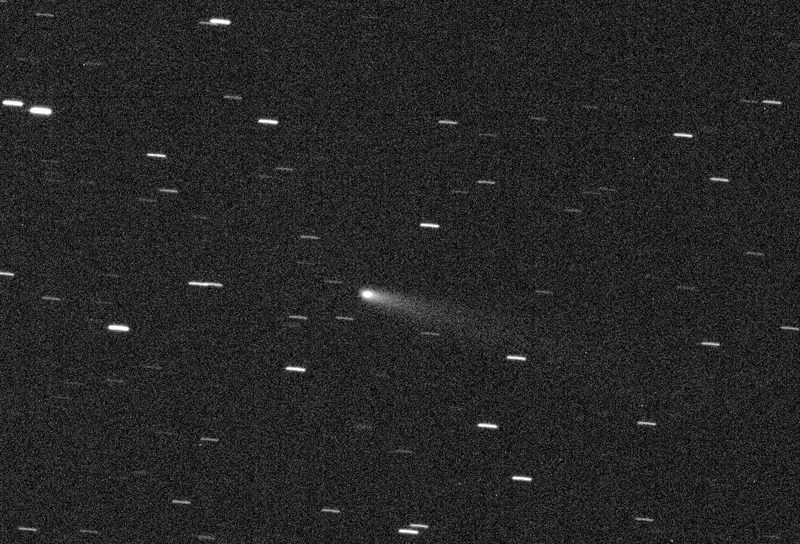
Hercules and southern Lyra, and at the time of its closest approach to Earth will be located in western Vulpecula some four degrees south-southeast of the star Albireo (Beta Cygni) and traveling at 5 1/2 degrees per day. On the following day the comet passes 20 arcminutes south of the planetary nebula M27, and eight days later (after crossing Delphinus and entering Pegasus) it passes one degree south of the globular star cluster M15. At the beginning of May it will be located in eastern Aquarius and will have slowed down to one degree per day; at an elongation of 46 degrees and south of the sun it will by then primarily be a southern hemisphere object. During the weeks after that the comet tracks in a generally eastward direction across Cetus, where it remains until the end of 2023; meanwhile, by the latter part of June it again becomes accessible from mid-northern latitudes.
Comet 364P may reach a peak brightness near 12th magnitude, possibly 11th, around the time of its closest approach to Earth, although unfortunately moonlight -- full moon taking place on April 6 -- will interfere with observations during this interesting period of time. I expect it to fade as it pulls away from Earth, and it will probably no brighter than 13th or 14th magnitude around the time of perihelion passage. By the time the comet becomes accessible again from my latitude in June I suspect it will have faded beyond the range of visual observations. It appears, then, that my period of viewing this comet will be fairly brief, and at best I will likely only obtain a handful of observations of it.
As I indicated in the entry for the 2018 return, at this comet's next return in 2028 (perihelion late April) it passes 0.50 AU from Earth in mid-March and, theoretically at least, may again become bright enough for visual observations, although I doubt if it gets any brighter than 13th or 14th magnitude. That, together with the fact that it will be crossing dense Milky Way star fields in Sagittarius during the time of its closest approach, along with the fact that this is well after my probable "retirement" date, suggests that whatever additional observations I am able to obtain this time around will be the final ones I ever obtain of this small and frequent visitor to the inner solar system.
INITIAL OBSERVATION: 2023 March 27.27 UT, m1 = 13.1, 0.5' coma, DC = 6-7 (41 cm reflector, 70x)
735. COMET ATLAS C/2023 E1 Perihelion: 2023 July 1.11, q = 1.027 AU
After a high level of cometary activity in early 2023 -- highlighted by the relatively brief naked-eye appearance of Comet ZTF C/2022 E3 (no. 722) -- that activity has dropped dramatically during recent weeks; by early May I was only following a couple of faint, distant long-period comets. I expect the comet activity to pick up again later this year, and in the meantime I've been able to add this new comet to help bridge the gap.
This particular comet was discovered on March 1, 2023 by the ATLAS program's telescope located in South Africa -- one of two ATLAS telescopes in the southern hemisphere that became operational in early 2022 (the other being based in Chile). Orbital calculations have shown this Comet ATLAS to be a Halley-type object with an orbital period of 85 years and to be traveling in a moderately-inclined direct orbit (inclination 38 degrees). At the time of its discovery the comet appeared as a faint and only slightly non-stellar object of 18th to 19th magnitude, however within the fairly recent past various images I've seen have shown the presence of a faint and diffuse extensive outer coma; a set of images I obtained via the Las Cumbres Observatory network a few nights ago also showed this. When I attempted the comet visually on the evening of May 9 I was able to detect it as a vague and diffuse object of 12th magnitude.
Comet ATLAS has now entered northern circumpolar skies, and is presently located three degrees north of the star Delta Ursae Majoris ("Megrez" -- the star where the Big Dipper's "handle" connects to the "bowl") and traveling almost due northward at half a degree per day. Over the coming few weeks it gradually begins curving eastward -- in the process passing 20 arcminutes east of the bright spiral galaxy NGC 4236 on June 2 -- and reaches a peak declination of +80.6 degrees on July 8, at which time it will be located roughly half-way between the stars Zeta and Epsilon Ursae Minoris in the "handle" of the "Little Dipper." Afterwards the comet's motion turns more southerly as it travels through eastern Draco, Cepheus -- passing 1 1/2 degrees southwest of the future North Pole Star Alpha Cephei on August 4 -- and then Cygnus, where it crosses the open star cluster M39 on August 12. On August 18 Comet ATLAS passes 0.37 AU from Earth, at which time it will be close to opposition and located in eastern Cygnus 1 1/2 degrees south of the star 72 Cygni and traveling just eastward of due south at slightly over two degrees per day. After that it gradually slows down as it pulls away from Earth, traveling southward through eastern Pegasus and then Aquarius -- passing less than 10 arcminutes west of the star Alpha Aquarii on September 6 -- where it remains until finally crossing into northeastern Piscis Austrinus in late October.
The large outer coma that Comet ATLAS has developed and its recent rapid brightening are not unusual phenomena in Halley-type comets. Although brightness predictions in a case like this are always a bit problemetical, I consider it a reasonable possibility that the comet could reach a peak brightness of at least 10th magnitude as it passes through perihelion and then makes its passage by Earth, and subsequently should remain visually detectable until perhaps sometime in October.
The most recent orbital calculations for Comet ATLAS suggest it should have previously returned to perihelion in early September 1937. Taking that at face value, the viewing geometry then was distinctly less favorable than it is this time around, with the comet's closest approach to Earth being a relatively distant 1.2 AU, and with its being located in the evening sky near an elongation of 50 degrees around the time of perihelion. Most of the photographic patrol programs of that era tended to concentrate on areas of the sky near opposition, and with a brightness of perhaps 12th magnitude it was probably a little too faint for the visual hunters then; thus, it is unlikely -- although certainly not impossible -- that records of the comet's appearance then might someday be identified.
INITIAL OBSERVATION: 2023 May 10.20 UT, m1 = 11.9, 2.5' coma, DC = 1 (41 cm reflector, 70x)
736. COMET 237P/LINEAR Perihelion: 2023 May 14.68, q = 1.987 AU
In many respects, this comet's story starts in June 2010, when the Wide-field Infrared Survey Explorer (WISE) spacecraft -- now retooled under the mission name NEOWISE -- discovered a faint comet in infrared images, which was soon found to be about 20th magnitude when observed by ground-based telescopes. Shortly after it was discovered it was found to be identical to an apparent asteroid, designated as 2002 LN13, that had been discovered in June 2002 by the LINEAR program in New Mexico, and followed for the next two months. Despite its stellar appearance at the time 2002 LN13 was found to be traveling in a distinctly cometary orbit with an orbital period of 7.2 years, and at the time of its re-discovery by WISE in 2010 it was located very close to its expected location.
The WISE discovery took place some six months after the comet's perihelion passage, and it remained a very faint object for the rest of that apparition. On the way back in to its next return it passed 0.41 AU from Jupiter in March 2013, which shortened its orbital period to 6.6 years and decreased its perihelion distance from 2.4 AU to its present value; after that it was duly recovered in early 2015 en route to its perihelion passage the following year. Since all the previously-reported observations suggested this was a faint and nondescript short-period comet I never considered it as something I might see visually, however in mid-2016 -- about two months after it had gone through opposition -- I started to read reports that suggested it might be worth attempting, and in late June I successfully detected it (no. 599) near 14th magnitude. I subsequently followed it on an occasional basis for the next four months, and when I last saw it in late October -- two weeks after perihelion passage -- when it was getting low in my southwestern evening sky it had brightened to slightly brighter than 13th magnitude.
On its current return Comet 237P was recovered on February 4, 2022 by the Pan-STARRS survey based in Hawaii. Reports and images I've seen over the past several weeks -- including a set of Las Cumbres Observatory (LCO) images I took in mid-April -- have suggested that it might be bright enough to detect visually, although when I attempted to do so during the latter part of April I couldn't convince myself I was seeing it. (The rich Milky Way star fields in Sagittarius that the comet was traveling through at the time didn't help in that effort.) Just within the past couple of weeks more recent images, including another set of LCO images I took, have suggested that it is even brighter now, and when -- after having to wait out a week of rainstorm activity that passed through New Mexico -- I attempted the comet again on the morning of May 22 I successfully detected it as a small and moderately condensed object of 13th magnitude.
Comet 237P just passed through perihelion a week and a half ago, and will be closest to Earth (1.06 AU) on July 8 and at opposition a few days later. It is presently located in far southern Aquila some two degrees northeast of the star 51 Aquilae and traveling towards the north-northeast at roughly 15 arcminutes per day; it remains in southern Aquila for the next five months, curving northward and then westward as it passes through its stationary point on June 8 and reaches a peak northerly declination of +0.9 degrees on August 2, after which it curves southward and then eastward as it passes through its other stationary point on August 22 and passes 10 arcminutes southwest of the star Iota Aquilae on September 15. There isn't much to go on as far as predicting its post-perihelion brightness behavior, but it might brighten by perhaps a half-magnitude or so by the time it passes closest to Earth and then might remain visually detectable for perhaps another month.
This becomes, incidentally, the third Periodic Comet LINEAR that I have seen on two or more returns, the other two being 209P/LINEAR which I observed in 2009 (no. 455) and in 2014 (no. 543), when it passed 0.055 AU from Earth; and 217P/LINEAR, which I observed on its discovery return in 2001 (no. 297), in 2009 (no. 459), and in 2017 (no. 620). Overall, I have visually observed 71 LINEAR-discovered comets, and including these multiple-return objects LINEAR now accounts for 75 comets on my tally, 10.2% of the grand total.
Although I have primarily focused on observing comets, throughout most of my visual observing "career" I have also observed numerous other phenomena, including novae and supernovae when reasonably bright ones have appeared, but as I have been winding down my visual activities during recent years I have significantly diminished that facet of my observing, with rare exceptions. One of these exceptions has now taken place, as on the same morning I added Comet LINEAR to my tally I also observed, for the first time, the recently discovered Supernova 2023 ifx in the nearby galaxy M101 at a relatively bright magnitude 11.2. (This supernova was discovered on May 19, 2023, by Japanese amateur astronomer Koichi Itagaki, who among his many other discoveries over the years re-discovered the long-lost periodic comet now known as 205P/Giacobini in 2008 (no. 438), which I also observed at the subsequent return in 2015 (no. 583), and discovered Comet Itagaki C/2009 E1 (no. 452).) Supernova 2023ifx is the 48th supernova I have visually observed, albeit the first one in almost 4 1/2 years, and is the brightest one I have seen since Supernova 2011fe (which also appeared in M101) in September 2011. As of right now Supernova 2023ifx is tied for the third-brightest supernova I have ever seen, although theoretically it may continue to brighten some more over the coming days.
INITIAL OBSERVATION: 2023 May 22.36 UT, m1 = 12.9, 1.2' coma, DC = 4-5 (41 cm reflector, 70x)
737. COMET LEMMON C/2021 T4 Perihelion: 2023 July 31.54, q = 1.483 AU
Any readers who have been with me throughout the long haul may remember that from 2007 through early 2012 I conducted a program entitled "Countdown to 500 Comets" that, as this name implies, marked my progress towards my 500th comet. Once I achieved that goal I kept on going, and while I might have originally entertained thoughts of eventually reaching Comet no. 1000, it has unfortunately become obvious to me over the past several years that that will not happen. To achieve that number I would have to maintain the same level of activity I exhibited during those years until at least my early 80s, and especially with the health issues that I began encountering a few yeas ago that just does not seem possible at this time. As recent readers may recall, I entered a state of "semi-retirement" from visual astronomical activities a little less than two years ago, and I am giving serious thought to "retiring" altogether around the end of 2024, although we will see what actually happens as that time approaches.
My current tally, meanwhile, shows that the intermediate goal of Comet no. 750 is definitely achievable within the not-too-distant future. Shortly after adding the previous comet to my tally I examined the various incoming comets -- both the expected short-period ones as well as already-discovered long-period ones -- and determined that there are twelve such comets that, provided my body and the area weather cooperate, I have a reasonably strong expectation of observing before the end of 2024. Under the assumption that I am successful in observing all of these comets -- which I have collectively dubbed the "Dependable Dozen" -- that means that I would only need two additional comets to achieve no. 750. Since I can think of several "maybes" among other incoming comets, and since it is quite likely that I will successfully observe some as-yet-undiscovered comets over the next year and a half, it is rather probable that I will reach Comet no. 750 well before all of the "Dependable Dozen" have arrived.
The first comet of the "Dependable Dozen" to appear on my tally was discovered back on October 7, 2021 by the Mount Lemmon Survey based in Arizona. At that time it appeared as an essentially asteroidal object of 20th magnitude, and calculations soon showed that it was traveling in a shallowly-inclined retrograde orbit (inclination 161 degrees, i.e., 19 degrees with respect to the ecliptic, but retrograde) and was a little less than two years away from perihelion passage. It went through opposition the following month, and then went through opposition again in late October 2022, with most reports around that time frame indicating a brightness between 15th and 16th magnitude. It was in conjunction with the sun in late March 2023 and about a month later began emerging into the morning sky, although since it was well south of the sun it was initially accessible only from the southern hemisphere. I took a set of images via the Las Cumbres Observatory facility at Siding Spring Observatory in New South Wales on May 22, and these showed the comet as being a relatively bright object almost certainly detectable visually, and after informing my colleagues in the southern hemisphere of this I read reports of their successful detections near 11th magnitude. By the latter part of June the comet had become accessible from my latitude -- albeit low in my southeastern sky just before dawn -- and on the morning of the 19th -- the now-official Federal holiday of Juneteenth here in the U.S. -- I successfully observed it as a moderately condensed object near magnitude 10 1/2.
At present Comet Lemmon is located in southwestern Cetus a little over four degrees southwest of the star Beta Ceti (Diphda, or Deneb Kaitos) and is traveling towards the south-southwest at 40 arcminutes per day. Over the next few weeks it accelerates and gradually curves more directly westward as it and Earth fly past each other going in opposite directions; it goes south of declination -40 degrees on July 9 and south of declination -50 degrees -- essentially becoming inaccessible from my observing site -- six days later, traveling through the constellations of Sculptor, Grus and Indus as it does so. The comet reaches its farthest south point of declination -56 degrees on July 21, when it will also be at opposition and closest to Earth (0.54 AU); at that time it will be located in southern Telescopium approximately 5 degrees west-northwest of the star Alpha Pavonis and traveling westward at almost four degrees per day. After that it begins curving northward and gradually slows down, traveling north of declination -50 degrees on July 27 and declination -40 degrees on August 2, while traveling through Ara, far southwestern Scorpius, Lupus, and Libra. The best period for accessibility from my latitude will be in late August and early September when it will be in western Libra and traveling northward at 15 to 20 arcminutes per day; on September 12 it passes just 8 arcminutes east of the prominent double star Alpha Librae. By the end of that month the comet becomes inacessible from my latitude as it begins disappearing into the dusk, and likewise from the southern hemisphere within another two to three weeks.
Based upon its present brightness, Comet Lemmon should reach a peak brightness of 9th magnitude, or slightly brighter, when it is nearest Earth in late July, thus providing a decent sight for my colleagues in the southern hemisphere. It should still be close to 10th magnitude by the time I can access it again during August, and may fade by perhaps another magnitude by the time I lose it a month later. I will thus probably not get very many observations of this first of my "Dependable Dozen," but there are others waiting in the wings . . .
INITIAL OBSERVATION: 2023 June 19.42 UT, m1 = 10.5, 3' coma, DC = 3-4 (41 cm reflector, 70x)
UPDATE (August 6, 2023): I was able to grab one additional observation of Comet Lemmon in late June, but moonlight and weather precluded any attempts the following month prior to its becoming inaccessible from my latitude. According to reports and images I've seen from observers in the southern hemisphere, the comet did reach a peak brightness near 9th magnitude around the time of its opposition and closest approach to Earth. By early August it had again become accessible from my location, and on the evening of the 5th -- at which time it was somewhat low in my southwestern sky at a declination of -35 degrees -- I picked it up again; at magnitude 10 1/2 it was somewhat fainter than I expected but was still relatively easy to see.
At present the comet is located in northeastern Lupus just to the northwest of the star Psi-1 Lupi and is traveling towards the northwest at 1 1/2 degrees per day. In keeping with the scenario described above, during subsequent weeks it slows down and curves more directly northward, and since it is now receding from both the sun and Earth it will likely fade fairly rapidly. Realistically, based upon its present brightness I will probably only see Comet Lemmon another two or three times, at best.
MOST RECENT OBSERVATION: 2023 August 6.15 UT, m1 = 10.5, 3.5' coma, DC = 4 (41 cm reflector, 70x)
738. COMET 185P/PETRIEW Perihelion: 2023 July 12.90, q = 0.930 AU
This is not one of the "Dependable Dozen" comets I mentioned in the previous entry, but it is one of the "maybes" that I alluded to in that same entry. Moreover, it is a comet to which I have a rather deep personal attachment. I discuss its overall history in the entries for its returns in 2012 (no. 506) and in 2018 (no. 636), but to summarize my involvement: after its original discovery in August 2001 I was asked by the Central Bureau for Astronomical Telegrams to provide confirmation, which I was able to do, both visually (no. 294) and with the CCD system I had operational at the time, the following morning. In the process I became the first person in the world to provide accurate astrometry for the comet, and am credited with its confirmation in its official discovery announcement.
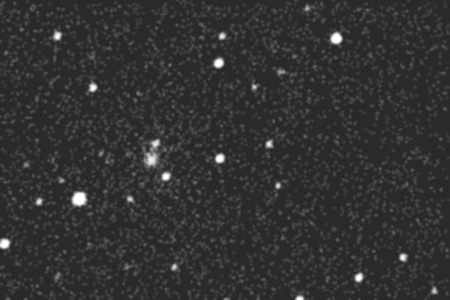
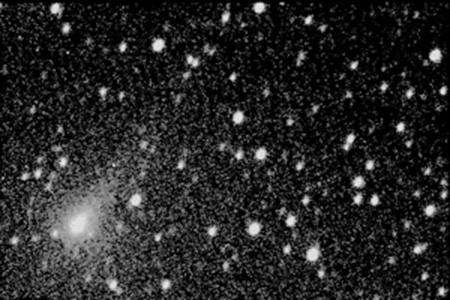 CCD images I obtained of Comet 185P/Petriew during its discovery return in 2001 (no. 294). LEFT: One of the short-exposure confirmation images I obtained on August 19, the morning after its discovery. (The comet is the slightly diffuse object left of center, between two stars.) RIGHT: A longer-exposure image I obtained on August 23.
CCD images I obtained of Comet 185P/Petriew during its discovery return in 2001 (no. 294). LEFT: One of the short-exposure confirmation images I obtained on August 19, the morning after its discovery. (The comet is the slightly diffuse object left of center, between two stars.) RIGHT: A longer-exposure image I obtained on August 23.
The comet was found to be a short-period object with an orbital period of slightly under 5 1/2 years, and I have successfully observed it on every subsequent return. On the present return it was recovered on May 3, 2023 by Japanese researcher Masayuki Suzuki utilizing a remotely-controlled telescope in Chile, who reported it as being a very faint object of 20th magnitude. It has brightened quite rapidly since then, and I managed to observe it visually just after it had cleared the trees to my east on the morning of June 23. In the rapidly brightening dawn sky it appeared as little more than a diffuse "presence" near magnitude 12 1/2, and I was only able to follow it for a few minutes.
The viewing geometry of this year's return is quite unfavorable, with the comet's remaining on the far side of the sun from Earth, and indeed it was at its closest to our planet (1.50 AU) a couple of days before my observation. At present it is located in eastern Aries about one degree northwest of the star Tau-1 Arietis and is traveling just northward of due east at 75 arcminutes per day, crossing into Taurus on June 26, passing 1 1/2 degrees south of the Pleiades star cluster (M45) four days later and then passing 35 arcminutes south of the Crab Nebula M1 on July 21. Its elongation, already down to 40 degrees at the time of my observation, decreases to 35 degrees by the time of perihelion passage and reaches a minimum of 32 degrees in early August before beginning a very gradual increase (not going above 40 degrees until late September).
Comet Petriew seeems to be about a magnitude fainter intrinsically than it was in 2018, apparently continuing a trend that I suspected during that return. Its faintness combined with the overall poor viewing geometry suggests I will not be seeing this comet much during the present return; it is entirely possible, in fact probable, that my initial observation will remain my only one.
I pointed out in the entry for this comet's 2018 return that the next return, in late 2028 (perihelion in late December), is relatively favorable -- the best one, in fact, since its original discovery return -- with a closest approach to Earth (0.87 AU) taking place in late January 2029, when it will be near an elongation of 66 degrees in the evening sky. However, as I have mentioned numerous times in these pages, it is more than likely that I will no longer be visually observing comets by that time, and if the comet continues its apparent intrinsic fading it may not be an easy object to observe anyway. It is thus rather probable that my observation on June 23 will be my final good-bye to this comet that marks a rather important moment in my overall career, and I am very glad I was able to obtain one final view of it this time around.
INITIAL OBSERVATION: 2023 June 23.43 UT, m1 = 12.5, 0.8' coma, DC = 1-2 (41 cm reflector, 229x; low altitude, twilight)
739. COMET 126P/IRAS Perihelion: 2023 July 5.33, q = 1.711 AU
The second comet of the "Dependable Dozen" to be added to my tally has the largest perihelion distance of all the comets in that group. It is also a long-time acquaintance that I have seen on two previous returns. With an orbital period of 13.4 years, it has the 9th-longest period of the comets that I have seen on two or more returns, and has the second-longest period of the comets that I have seen on three or more returns, behind only Comet 29P/Schwassmann-Wachmann 1.
The comet was originally discovered in June 1983 by the InfraRed Astronomical Satellite (IRAS), one of six comets -- seven if one includes the "rock comet" (3200) Phaethon -- that spacecraft mission discovered during its 10-month operational lifetime. Originally reported as being around 15th magnitude, it reached a peak brightness near 11th magnitude following its perihelion passage in late August, and I followed it for about two months (no. 61). I was living in southern California at the time, and although my primary observing instrument then was the 8-inch (20 cm) reflector I had purchased three years earlier from Meade Instruments, I had an especially memorable observation one night in mid-September through a Meade DS-16 16-inch (41 cm) reflector owned by Bob Lunsford -- now Journal Editor of the American Meteor Society -- that revealed a distinct dust tail about 15 arcminutes long. It was probably that observation more than any other that convinced me I wanted a telescope of that aperture, a wish that would be fulfilled four years later, after I had relocated to New Mexico where I had a permanent residential observing site.
Comet P/IRAS returned during the latter part of 1996 and I followed it for about a month and a half (no. 221), with its reaching a peak brightness near 12th magnitude. It returned again in early 2010 under unfavorable viewing geometry, and although it was duly recovered and followed for over a year and a half, I never attempted it.
On its present return Comet P/IRAS was recovered on March 9, 2023 by Indian amateur astronomer Nirmal Paul utilizing the remotely-operated Slooh telescope in Chile. It was about 17th magnitude at the time, and has brightened gradually since then, remaining in the eastern morning sky (and, since it was south of the sun, primarily accessible from the southern hemisphere). By about mid-June it was starting to become accessible from the northern hemisphere as well, and some images I took via the Las Cumbres Observatory network suggested it might be bright enough to detect visually, however when I made such an attempt near the end of that month I was unsuccessful. An additional set of LCO images I obtained in mid-July showed that it had brightened further, but when I made another visual attempt on the morning of July 17 I still couldn't convince myself I was seeing it. However, it was located in a poor star field at that time, and when I attempted it again two mornings later (when it was located in a better star field) I was able to detect it as a very faint and small object of 14th magnitude, that exhibited the expected motion over the course of about 20 minutes.
At present the comet is located in western Aries about two degrees south-southwest of the star Theta Arietis, and -- traveling in an orbit with an unusually high (for a Jupiter-family comet) inclination of 46 degrees -- is heading towards the north-northeast at 40 arcminutes per day (passing just 5 arcminutes west of that star on July 23). During the next few weeks it traverses central Aries, eastern Triangulum, and (starting after mid-August) western Perseus, gradually curving more directly northward; on August 27 it crosses the eastern regions of the open star cluster M34 and four days later is at its stationary point. Now traveling towards the north-northwest, the comet starts to enter northern circumpolar skies during the latter part of September, crossing the western regions of the open star cluster NGC 957 (1 1/2 degrees east of the "Double Cluster") on September 19, at which time it is closest to Earth (1.28 AU). Two days later it crosses into Cassiopeia, is at opposition just before mid-October, then crosses into Cepheus shortly before the end of that month and reaches a peak northerly declination of +70.6 degrees a couple of days later. Afterwards it remains in southern Cepheus as it recedes, and passes through its other stationary point at the end of November.
To my eyes, the comet seems to be about 1 1/2 magnitudes fainter, intrinsically, than it was in 1983, and about a half-magnitude fainter than it was in 1996. Since it is still approaching Earth (albeit already past perihelion) it may brighten slightly over the next few weeks, but probably not by more than a half-magnitude at best, and since it will be entering the rich star fields of the Perseus Milky Way (which will make observations more difficult than they otherwise would be) by the latter part of August I will probably at most be obtaining just a handful of additional observations.
I am nevertheless glad to track down this long-time acquaintance for one additional return. In reflecting upon its overall history, it occurs to me that P/IRAS' various returns have coincided with significant events and changes in my personal life. I was following it during its discovery return in 1983 at the same time that I was getting out of the U.S. Navy, and the return in 1996 coincided with the inbound phase of the naked-eye appearance of Comet Hale-Bopp (no. 199); indeed, I had just observed Hale-Bopp at around magnitude 5 1/2 half an hour before adding P/IRAS to my tally. Although I didn't see the comet in 2010 that return coincided with my divorce, my encountering the "empty nest" syndrome, and my relocation to my present residence. The return before its discovery, in mid-1970, took place around the time I first began observing comets, and the return before that, in mid-1957, took place nine months before I was born and thus coincides with the time of my conception. (Incidentally, a close approach to Saturn -- 0.05 AU -- in December 1950 had placed the comet into its present orbit.)
The present return, of course, takes place as I have been making plans to wind down my visual observing "career," although I hope (!) there are no significant unforeseen changes in my personal life during the near-term future. As for the return after that, in October 2036, I'm not really sure I want to speculate about any such changes that might happen then. For what it's worth, the viewing geometery then is quite favorable, although if the comet continues its intrinsic fading I rather doubt I will be observing it, even in the unlikely possibility that I am still actively engaging in any visual observational activities. (Although, if I were to continue adding comets to my tally at the rate I have been doing for the past couple of decades, I should actually be quite close to Comet no. 1000 around that time -- but, as I've often indicated in these pages, I don't foresee that happening.)
INITIAL OBSERVATION: 2023 July 19.42 UT, m1 = 14.2, 0.4' coma, DC = 3-4 (41 cm reflector, 229x)
740. COMET 12P/PONS-BROOKS Perihelion: 2024 April 21.12, q = 0.781 AU
I have been waiting a long time for this comet (and, yes, it is the third comet of the "dependable dozen" to appear on my tally). It is one of the "classical" Halley-type comets and has a current orbital period of approximately 71 years, and I learned of its existence rather early in my pursuit of astronomy. About a quarter-century ago I first encountered detailed predictions that it would be returning to perihelion in 2024, and ever since then I have kept that fact in the back of my mind, in the expectation that when that time finally arrived -- under the assumption that I would still be alive and actively observing -- I would be seeing it. And now, indeed, that time has arrived . . .
Comet Pons-Brooks' name links together two of the champion comet discoverers of the 19th Century. I discuss its overall history in one of the "Comet of the Week" presentations I wrote as part of "Ice and Stone 2020" three years ago -- an effort to look towards the near-term future (at that time). To summarize that history: the comet was originally discovered on July 21, 1812 by the French astronomer Jean-Louis Pons, unquestionably the champion comet discoverer of his era. It reached a peak brightness near 4th magnitude and was followed for about two months, which was long enough for the astronomers of that time to determine that it had an approximate orbital period of 70 years. It was accordingly expected to return in the early 1880s, however despite several searches it remained undetected; then, on September 2, 1883, William R. Brooks in New York -- one of the top comet discoverers of that era -- discovered a comet which turned out to be none other than Pons' expected comet. It passed perihelion in January 1884 under relatively favorable geometrical circumstances, passing 0.64 AU from Earth in the process, and reached a peak brightness near 3rd magnitude.
Comet Pons-Brooks next passed perihelion in May 1954 -- just a little less than four years before I was born -- and was recovered by Elizabeth Roemer at Lick Observatory in California in June 1953. The viewing geometry during that return was relatively poor, but it nevertheless reached a peak brightness near 6th magnitude.
During recent years German amateur astronomer Maik Meyer (and colleagues) have attempted to identify previous returns of Comet Pons-Brooks in historical records. Their most recent analysis, published two years ago, concludes that Pons-Brooks was definitely observed from Italy and from China in early 1457, and from China and from several places in Europe around October 1385; both of those returns took place under favorable viewing geometry and the comet reached a peak brightness near 2nd or 3rd magnitude both times. While nothing conclusive can be said about earlier returns, there is a reasonable possibility that a comet observed from China in September of A.D. 245 may have been Pons-Brooks.
When I wrote the aformentioned "Ice and Stone 2020" presentation the comet had not yet been recovered, although I mentioned the possibility that that event might happen "within the not-too-distant future." Just two months later, on June 10, 2020 (with confirming images taken one week later) Pon-Brooks was indeed recovered by a team of astronomers led by Matthew Knight utilizing the 4.3-meter Lowell Discovery Telescope in Arizona. The comet, located at a heliocentric distance of 11.9 AU, appeared as a very faint object of 23rd or 24th magnitude, and exhibited a short tail which indicated that it was already active.
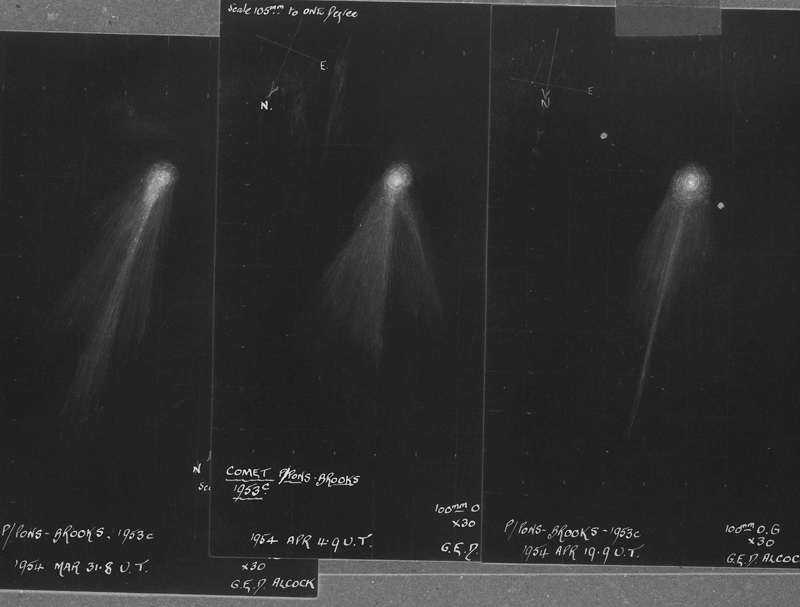
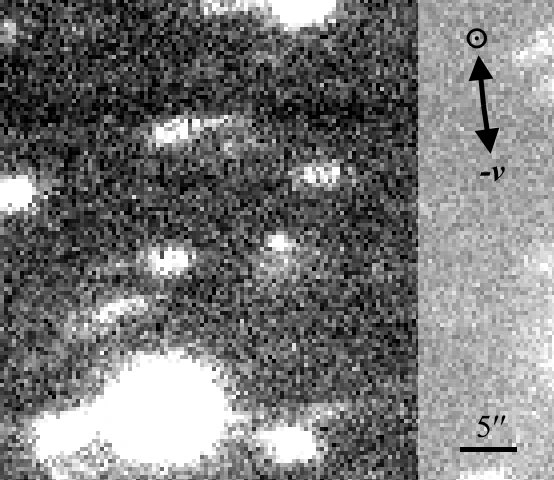 LEFT: Sketches of Comet Pons-Brooks by British amateur astronomer George Alcock on three nights in March and April 1954. RIGHT: One of the recovery confirmation images obtained by Matthew Knight et al. with the Lowell Discovery Telescope on June 17, 2020. The comet is the small, faint object in upper center (below the trailed image of a brighter star). Image courtesy Quanzhi Ye.
LEFT: Sketches of Comet Pons-Brooks by British amateur astronomer George Alcock on three nights in March and April 1954. RIGHT: One of the recovery confirmation images obtained by Matthew Knight et al. with the Lowell Discovery Telescope on June 17, 2020. The comet is the small, faint object in upper center (below the trailed image of a brighter star). Image courtesy Quanzhi Ye.
Since its recovery Comet Pons-Brooks has brightened slowly and gradually as it has approached the inner solar system. It went through opposition in late June 2022, and on the night of October 12-13 I successfully obtained a pair of images with one of the 1-meter Las Cumbres Observatory telescopes located at McDonald Observatory in Texas; it appeared as a very faint object near 20th or 21st magnitude. After being in conjunction with the sun just before the end of 2022 it began emerging into the morning sky around February 2023 and since then has been observed regularly by astronomers around the world. I have been imaging it on a semi-regular basis with the LCO telescope network since early April, and when I did so in mid-July (just two weeks after the comet was at opposition) it was close to 17th magnitude and was exhibiting a distinct, albeit short, tail.
During both its 1883-84 and 1953-54 returns Comet Pons-Brooks underwent several distinct and significant outbursts as it was approaching perihelion, and accordingly there was good reason to believe it would do so this time around as well. This has indeed now happened: on July 20 an amateur astronomer in Hungary, Elek Tamas, reported that it had suddenly brightened by about 5 magnitudes, to magnitude 11 1/2, and this was very shortly thereafter confirmed by other observers and announced worldwide. Fortunatately -- this is, after all, monsoon season here in New Mexico, although thus far the monsoon this year has been relatively weak -- I had clear skies that evening, and successfully observed the comet as a stellar-appearing object of magnitude 11.5. At around that same time I successfully obtained images via the LCO facility at McDonald that clearly show the comet as being in outburst.
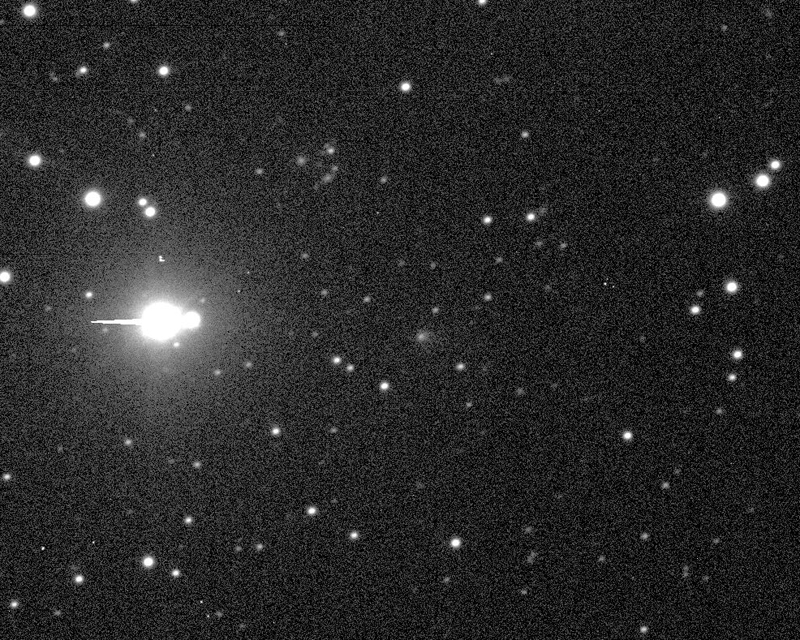
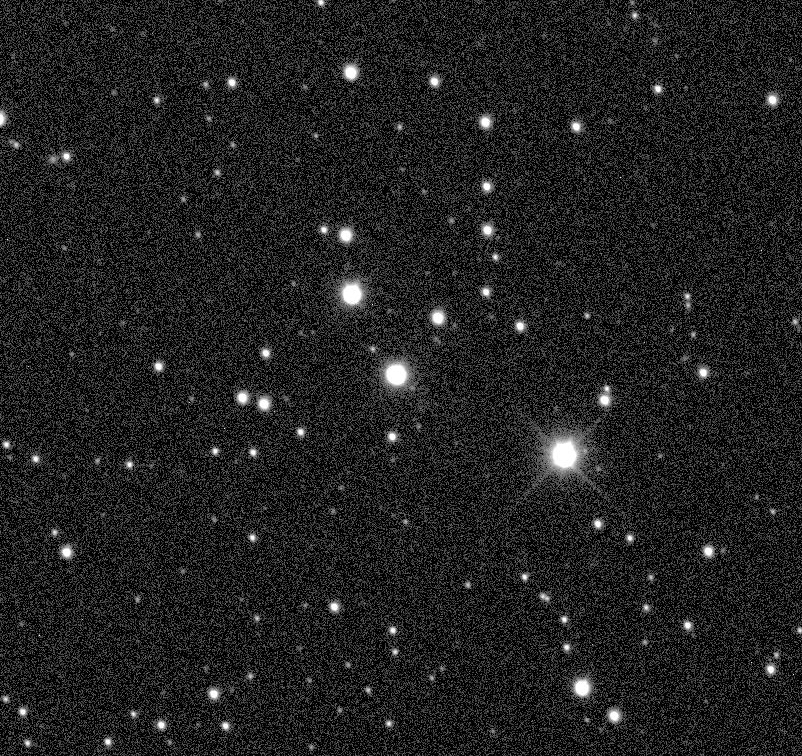
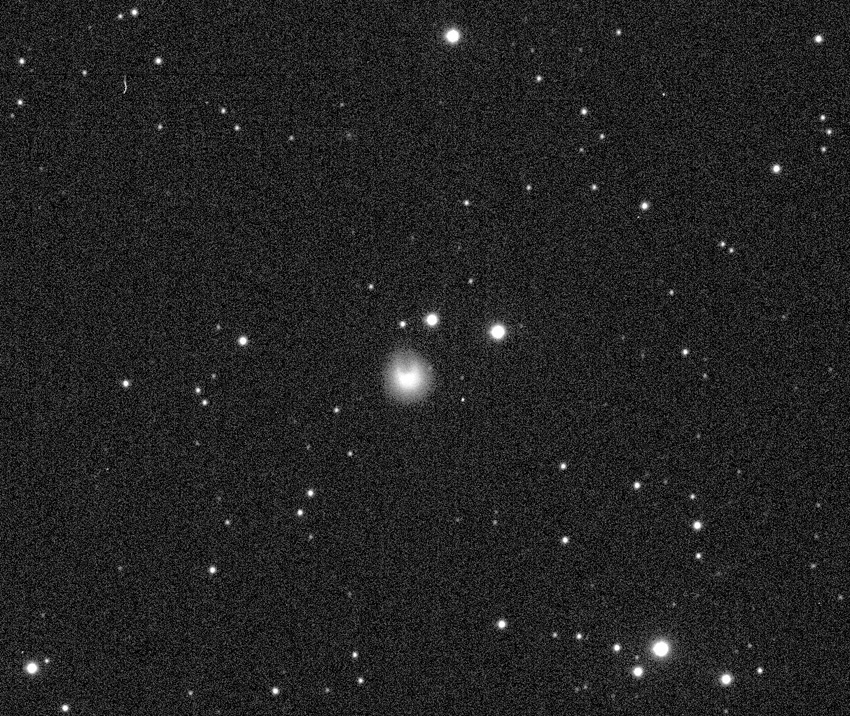 Images of Comet Pons-Brooks I have obtained via the Las Cumbres Observatory network. LEFT: July 14, 2023 (six days before its outburst), from LCO-Tenerife in the Canary Islands. CENTER: Night of July 20-21, 2023 -- 8 1/2 hours after Elek Tamas' report of the outburst, and half an hour before my first visual observation -- from LCO-McDonald. The comet is the bright starlike object in the center; there is a star of similar brightness to its upper left. RIGHT: July 23, 2023 -- three days after the center image -- from LCO-Tenerife. The coma is starting to expand out and is exhibiting a "horseshoe crab" shape (with "horns" extending towards the north).
Images of Comet Pons-Brooks I have obtained via the Las Cumbres Observatory network. LEFT: July 14, 2023 (six days before its outburst), from LCO-Tenerife in the Canary Islands. CENTER: Night of July 20-21, 2023 -- 8 1/2 hours after Elek Tamas' report of the outburst, and half an hour before my first visual observation -- from LCO-McDonald. The comet is the bright starlike object in the center; there is a star of similar brightness to its upper left. RIGHT: July 23, 2023 -- three days after the center image -- from LCO-Tenerife. The coma is starting to expand out and is exhibiting a "horseshoe crab" shape (with "horns" extending towards the north).
As I write these words the coma has started to expand outward, and at least for the time being in various images is exhibiting a shape that has been likened to that of a "horseshoe crab" (although I can't quite convince myself that I'm detecting this visually). Over the slightly longer term the outburst may well fade out over the next two to three weeks and the comet's overall brightness may drop below the level of visual detectability, however if the pattern that it has exhibited during its previous returns is repeated there may well be additional outbursts -- probably not quite as strong as this one -- over the next few months. By perhaps November the comet's overall brightening trend should bring it to a point where it is continuously visually observable,
At present Comet Pons-Brooks is located just east of the "head" of the constellation Draco three degrees east-southeast of the star Xi Draconis, and having just passed through its farthest-north point (declination +55.8 degrees) is traveling almost due westward at just under 15 arcminutes per day. It spends most of August traversing the "Dragon's head," in the process beginning a gradual turn towards the southwest and remaining within one degree -- curving from north to west -- of the star Beta Draconis during the last week of the month. After crossing into northeastern Hercules shortly before mid-September the comet continues curving more and more southward, passing through its stationary point on September 21 and thereafter traveling towards the southeast but curving more and more directly eastward. After crossing into Lyra during the last week of November and passing half a degree south of the bright star Vega on December 6, the comet will cross into western Cygnus shortly before the end of 2023, at which time it will be traveling almost due eastward at slightly over half a degree per day.
As fate would have it, the viewing geometry of the current return is relatively unfavorable -- albeit slightly better than it was in 1954 -- with the comet's remaining on the far side of the sun from Earth as it makes it final approach to perihelion. During January 2024 it crosses eastward across the rich star fields of the Cygnus Milky Way, then passes half a degree south of the famous nearby star 61 Cygni on January 28 before crossing into southern Lacerta during the second week of February and then into Andromeda during the latter days of that month. Now curving more directly towards the southeast, the comet crosses into northern Pisces in mid-March and then into Aries in early April, at which time it will be traveling at slightly over one degree per day. Meanwhile, the elongation from the sun steadily shrinks, dropping below 40 degrees during the second week of March, below 30 degrees just before the end of that month, and reaching a minimum of 22 1/2 degrees around the time of perihelion passage, when it will be located in western Taurus just 15 arcminutes north of the star Xi Tauri.
By this time the comet will have become inaccessible from the northern hemisphere, but as it continues its southeastward trek it becomes visible from the southern hemisphere, although the elongation remains fairly small for some time, not climbing above 30 degrees until the second week of May and not above 40 degrees until just before the end of that month. During this time it crosses Taurus, Eridanus, Lepus, Canis Major, Puppis, and eventually Vela; it is actually nearest Earth (1.55 AU) on June 22 and crosses south of declination -40 degrees on July 10. After remaining in Vela for about five weeks the comet crosses into Centaurus shortly before mid-August.
Despite the relatively poor viewing geometry, Comet Pons-Brooks is fairly bright intrinsically, and thus it should at least reach dim naked-eye visibility. Irrespective of any additional outbursts it might undergo, based upon its general brightness behavior during previous returns it may reach 10th magnitude in January 2024, 8th magnitude by sometime in February, 6th magnitude by perhaps mid-March, and a peak brightness between 4th and 5th magnitude during April (albeit, again, at a small elongation). The post-perihelion brightness behavior is not as well documented as the pre-perihelion behavior, but the comet may still be 6th magnitude during May, 8th magnitude during June, 10th magnitude during July, and perhaps may remain visually detectable until August or September.
It so happens that during the total solar eclipse on April 8, 2024, Comet Pons-Brooks will be located 25 degrees northeast of the sun, and presumably should be close to its maximum brightness. While my primary priority during the eclipse will be obtaining an observation of any Kreutz sungrazer (or other near-sun comet) that might be close to the sun at that time, in the very distinct possibility that there is no such object then it is accordingly conceivable that I might attempt to observe Pons-Brooks during totality -- that would certainly be an unusual and unique observation!
It is unfortunate that the sole return that Comet Pons-Brooks will make during my lifetime (and the lifetimes of my contemporaries) takes place under such unfavorable viewing circumstances. However, as I mentioned above, the previous return, in 1954, was even more unfavorable, and it turns out that the next return, in 2095 (perihelion mid-August), is also quite unfavorable. I am therefore glad that as I wind down my visual observing "career" I am able to view this visitor that I have been awaiting for so long. I accordingly leave observations in 2095 to any comet observers of that era, and I'm not at all sure I can even speculate about the world they will inhabit at that time. I hope it's a good one.
INITIAL OBSERVATION: 2023 July 21.16 UT, m1 = 11.5, 0.0' coma, DC = 9 (41 cm reflector, 70x)
MOST RECENT OBSERVATION: 2023 July 24.28 UT, m1 = 11.7, 1.0' coma, DC = 7 (41 cm reflector, 70x)
UPDATE (October 7, 2023): Following its outburst in July Comet Pons-Brooks' coma expanded and diffused out, although its overall brightness remained fairly constant, dropping not much more than half a magnitude or so according to my measurements. When I observed it in early September it appeared as a vague diffuse glow about 7 arcminutes in diameter and still with a total brightness of 12th magnitude. During the interim its nuclear region apparently underwent a couple of "mini-outbursts," but these didn't affect the comet's overall total brightness. However, on the night of October 4-5 Comet Pons-Brooks underwent a new major outburst, that was recorded by various observers around the world. It so happens that I had ordered up some images that night via the Las Cumbres Observatory network, and when I examined these (which were taken from LCO's facility at Haleakala Observatory in Hawaii) it was clear that something significant was going on. I had apparently caught the comet "in the act," and because of some fortuitous timing my images helped constrain the time of the outburst. Meanwhile, on the following night I observed the comet visually, and could easily detect it as a near-stellar object of 11th magnitude, with a faint wisp of diffuseness surrounding the bright central condensation.
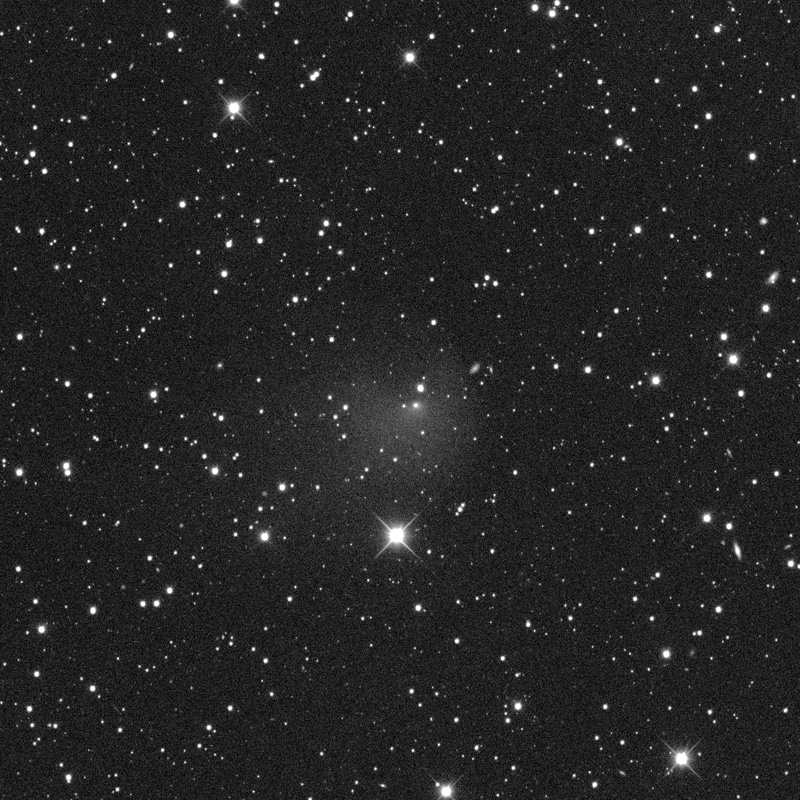
 Images of Comet Pons-Brooks I have obtained via the Las Cumbres Observatory network. Both images are 3-minute exposures, with field dimensions of 30x30 arcminutes. LEFT: September 4, 2023, from the LCO facility at McDonald Observatory in Texas. RIGHT: October 5, 2023, from the LCO facility at Haleakala Observatory in Hawaii.
Images of Comet Pons-Brooks I have obtained via the Las Cumbres Observatory network. Both images are 3-minute exposures, with field dimensions of 30x30 arcminutes. LEFT: September 4, 2023, from the LCO facility at McDonald Observatory in Texas. RIGHT: October 5, 2023, from the LCO facility at Haleakala Observatory in Hawaii.
At present Comet Pons-Brooks is located in northeastern Hercules three degrees west of the star Iota Herculis (and a similar distance north-northeast of the globular star cluster M92), and is traveling towards the south-southeast at approximately 12 arcminutes per day, although during the next few weeks it starts to speed up and curve more directly eastward. (Its overall travels over the next few months are described above.) I expect the current outburst to proceed more-or-less as the first one did, i.e., with the coma gradually expanding and diffusing out over the next month or so. It is entirely possible that there may be additional outbursts as the comet approaches perihelion, although before too much longer its overall brightening trend should bring it within the range of being continuously detectable visually.
MOST RECENT OBSERVATION: 2023 October 6.08 UT, m1 = 11.0, 0.7' coma, DC = 8 (41 cm reflector, 70x)
UPDATE (November 16, 2023): Comet Pons-Brooks continues to exhibit dramatic outburst activity as it approaches perihelion, still over five months away at this writing. It underwent another strong outburst just before the end of October, then a second strong outburst just a day later that brought its total brightness up to about magnitude 10 1/2. As before, its coma began fading and diffusing out, however on November 15 it underwent yet another outburst -- one of the strongest thus far -- and that evening I was able to detect it in 10x50 binoculars as a just slightly non-stellar object of 9th magnitude. In the 41 cm telescope it appeared as a bright near-stellar disk a little over half an arcminute across, embedded within a faint outer coma roughly two arcminutes in diameter.
Like it has done previously, the comet will likely start diffusing out, perhaps with some fading, over the coming days and weeks, although it may very well experience additional outbursts during the near- to intermediate-term future. We are now close to the point where the comet should be bright enough to be visually detectable even without contribution from outbursts, and in any event it will be most interesting to see what else Pons-Brooks might have in store for us as it completes its journey to perihelion.
MOST RECENT OBSERVATION: 2023 November 16.06 UT, m1 = 8.7, near stellar, DC = 8 (10x50 binoculars)
UPDATE (March 11, 2024): Comet Pons-Brooks has continued to undergo occasional outbursts as it approaches perihelion, although these later ones have not been as dramatic as the initial ones. The comet's overall brightness, meanwhile, has increased rather steadily, and it was a relatively easy binocular object throughout the first two months of 2024. By the beginning of March I was suspecting naked-eye visibility, and on the evening of March 10 -- two days after the biggest snowstorm of the current winter (8-10 inches, or 20-25 cm) -- I could definitely, albeit faintly, detect it with my unaided eye once the sky had darkened towards the end of dusk.
 Photo of Comet Pons-Brooks I took on the evening of March 10, 2024. The comet is just to the right of the top of a tree branch, with a faint tail extending slightly upward and to the right. The Andromeda Galaxy (M31) is in the far upper right.
Photo of Comet Pons-Brooks I took on the evening of March 10, 2024. The comet is just to the right of the top of a tree branch, with a faint tail extending slightly upward and to the right. The Andromeda Galaxy (M31) is in the far upper right.
At present Comet Pons-Brooks is running approximately one magnitude brighter than the original projections for this time. If it maintains this trend, it should be near 4th magnitude late this month and during early April (including during the total solar eclipse on April 8), and may even be slightly brighter than that when near perihelion.
MOST RECENT OBSERVATION: 2024 March 11.09 UT, m1 = 5.5, 7' coma, DC = 5, 1 degree tail in p.a. 015 (10x50 binoculars)
<-- Previous
Next -->
BACK to Comet Resource Center